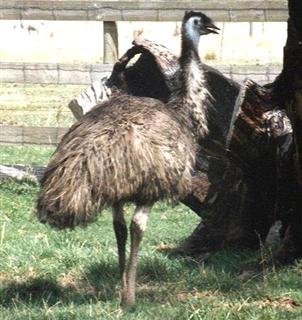Emu
Scientific Name: Dromaius novaehollandiae
Thu, 3rd July, 2025 - 7:42 am GMT
Sponsor Ads:

Alternative Name
Scientific Name: Dromaius novaehollandiaeBasic Info
Emus are very large birds. They can reach about six feet (about two meters) in height and weigh between 110 and 120 pounds. Some captive Emus will even exceed 120 pounds. Emus have rudimentary wings that are about 1/10 the length of their bodies. They have brown plumage that is very dark when new and then pales to light brown before molting. The bases of the feathers are white and each feather has two shafts. The barbs on the feathers are widely spaced and resemble hair, as opposed to the firm vane made by feathers on most birds. Feathers near the base of the spine have long barbs and resemble a mop like tail. The Emu's head and neck are often featherless and has a bluish color. The males and females are almost identical in appearance. Females generally outweigh males somewhat and, prior to laying eggs, the female has black feathers on the head and neck. Emu chicks are cream with brown stripes and dark dots on the head. Emus live five to ten years in the wild and can live much longer in captivity.
Health
Caring for Emus in captivity is quite easy and routine. Breeding pairs do best in pens at least 1500 square feet with a length of over 70 feet, though exceptions exist. Perimeter fencing should be at least 6 feet high to minimize escapes. Interior fencing may be shorter. Many fence materials work equally well though 6 foot 11 gauge no climb fence is a good choice, because it lacks the crushability of chain length, making it a lot harder to destroy than welded wire and it does not leach minerals like cattle panels or un-galvanized metals. Young emus are vulnerable to disease for the first 10 days of life. If the facilities are cleaned, ventilated well and heated baby Emus are very hardy critters. Once they are 90 days old they are very strong. Care should be taken to avoid overcrowding of babies, as they can suffocate. Also injuries during the rapid growth period often result in leg problems if they are not aggressively treated. The damage does not heal as quickly as the bodies are growing. Emu babies do not suffer from stress or impaction as ostrich babies do. Emu babies grow rapidly, and facilities and pen sizing should provide for adequate space for them to run and develop. Feeds need to contain the vitamins, minerals, grit and nutrition in nearly every bite for maximum success, since they have a 4 hour digestive tract. Outside of care for babies, outdoor adult pens rarely need cleaning as the feces deteriorates in the sun and absorbs into the soil with the rain. Interior shelters should be kept clean: chopped straw, wood shavings, sunflower husks work very well to minimize labor time and facilitate ease of cleaning. Emus should have shelter but do not need heat unless they are babies. To avoid parasite infestation, feeding and watering is performed in the shelters. Clean fresh water should be available 24 hours a day year-round. If good clean bedding and shelter is provided Emus will spend even winter days outside and return to the shelter when they get cold. Active bio-security programs are recommended to avoid problems. Regular vaccinations for WEE & EEE are recommended. Breeding Emu in captivity that are not related or closely related and are from bloodlines with proven hatching and survivability records, and which are paired through natural selection do extremely well. You can expect 20 to 30 eggs regularly with many pairs providing 30 to 40 annually. Fertility is very high and most chicks hatch easily through artificial incubation. If allowed to sit on the eggs (in climates permitting) males will hatch out 9 to12 eggs. Removal of eggs for artificial incubation is easy in captivity and very dangerous in the wild. After eggs are laid the incubation period in captivity is 49 to 52 days. The average Emu eggs weighs about 550 grams, but they range from 180 grams to over 900 grams, for eggs laid in captivity Pairing by natural selection (self choosing) is preferable to forced pairing if you want fast bonding and wish to minimize fence jumping and physical injury to the emu.Habitat
Rarely seen in populated areas, the Emu flourishes in Australia's national parks and wildlife reservesBehavior
The Emu is Australia's largest bird. Like other members of the Ratite family, Emus are flightless. They are, however, capable of running at great speeds. They are common in Australia. Male Emus are responsible for hatching the eggs. The female lays a clutch of five to fifteen eggs between May and August, and then leaves to join a group of other Emus. The Emu's nest is generally a shallow depression made with leaves, grass and bark next to a bush. After the female lays the eggs, the male then incubates the eggs for about nine weeks. After the chicks hatch, they leave the nest after about two or three days. However, the male Emu guards the chick until they are full-grown, between six and eighteen months. The Emu's eggs weigh about 750 grams and are dark green with a rough surface. Because of their considerable size, Emu eggs are often eaten by predators. The Emu is a migratory animal. Although it is unable to fly, they run at great speeds, 30 to 40 miles per hour, and can sustain these speeds for long distances. A group of Emus may travel hundreds of kilometers in a season. Emus are generally social animals. They commonly form small groups, although they may congregate in mobs of thousands. Emus were once common in Tasmania, Kangaroo Island and King Island, but they were mostly exterminated.Origin
AustraliaHistory
Although the Emu is native to Australia, they are found commercially in many countries around the world. Emus are quite a lucrative industry. Every part of the Emu can be used for something: the meat is similar to beef in taste and similar to venison in texture but is much lower in fat and cholesterol; the hide makes a soft leather with a beautiful quill pattern; Emu oil, high in oleic acid, enhances penetration of bioactive components; Emu feathers are used for hats, fishing lures and feather dusters; eggshells and claws are carved into jewelry; and the eggshells are thought to encourage bone growth, healing and restoration. When European explorers first reached Australia, they exterminated most of the Emus. However, the population has grown a lot since then and Emus are now quite common in the regions in which they live. Emu's are currently being raised in the United States for their lean red meat and food by-products. Harvested birds produce 25 to 35 pounds of heart healthy red meat, between one to two gallons of oil, three fourths to one pound of feathers (used in crafts and fishing), six claws (used in jewelry) and a soft hide suitable for clothing. There are over a thousand emu farms in the U. S. Breeding season in the U. S. is from October through April.Common Foods
In the wild, Emus primarily feed on grasses and other vegetation. They are also fond of large insects and caterpillars. To aid in digestion, the Emu swallows large stones into its gizzard.Sponsor Ads:
"Christians, like slaves and soldiers, ask no questions." -- Jerry Falwell (August 11, 1933 - May 15, 2007)
Emu
Coded by: BGID® | ALL RIGHTS RESERVED Copyright © 2000-2025
Disclaimer | Privacy | Report Errors / Contact | Credits








 President of the United States of America - Real Estate mogul, Pageant owner and now one of the most controversial men in political history.
President of the United States of America - Real Estate mogul, Pageant owner and now one of the most controversial men in political history.  Global warming has been in and out as the "latest" hot topic for many years. It is, according to modern scientists, the result of man-made industrial pollutants, clearing forested areas, agriculture, etc. But now they are thinking it started way before the Industrial Revolution...
Global warming has been in and out as the "latest" hot topic for many years. It is, according to modern scientists, the result of man-made industrial pollutants, clearing forested areas, agriculture, etc. But now they are thinking it started way before the Industrial Revolution...  Politician, US Vice President and President of the USA - Joseph Robinette Biden Jr.
Politician, US Vice President and President of the USA - Joseph Robinette Biden Jr.  versus
versus  Russia: 'The Evil Empire'? Are they all that bad or is it just the USA trying to portray Russia as bad because they are a world power with land bigger and a society very different from the USA ideal?
Russia: 'The Evil Empire'? Are they all that bad or is it just the USA trying to portray Russia as bad because they are a world power with land bigger and a society very different from the USA ideal? 
 Corona virus
Corona virus 
 Users with wide screen monitors can benefit from more content on every page.
Users with wide screen monitors can benefit from more content on every page.